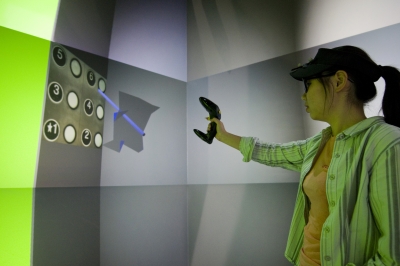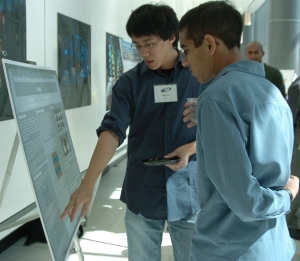Announcing the 2009 Calit2 UC San Diego Undergraduate Summer Research Scholars
By Maureen C. Curran
|
San Diego, CA, April 29, 2009 — Undergraduates majoring in 15 different fields will be working with faculty advisors from across campus as full-time researchers this summer, as awardees of UC San Diego division of Calit2 Summer Research Scholarships. This is the ninth year of the highly successful program.
"It has been a great opportunity for students and faculty to work together on a broad spectrum of research topics," said Bill Hodgkiss, associate director of the UC San Diego division of Calit2.
The ten-week program, which begins in late June, gives undergraduates the unique opportunity of being paid full-time student researchers actively involved in the research of their faculty mentor´s lab, doing hands-on work that is usually reserved for graduate students, senior researchers and faculty.
The goal of the program is to help talented undergraduates better define their career goals and fields of interest. This year's 25 recipients will work with a diverse group of advisors.
The 25 faculty members serving as advisors cover a wide range of fields: four departments in the School of Medicine (medicine, pathology, psychiatry and surgery), four departments in the Jacobs School of Engineering (bioengineering, computer science and engineering, electrical and computer engineering and nanoengineering), and the departments of biology, neuroscience, political science and visual arts. Some of the advisors are also affiliated with Calit2, the Moores Cancer Center, San Diego Supercomputer Center (SDSC), the Salk Institute, the Center for Advanced Computational Science Engineering (CACSE) or the Center for Research on Biological Systems (CRBS).
To enhance the research experience for the scholars, there are weekly sessions which include seminars, building tours and presentations. The seminars offer insight into a number of aspects of academic research and career planning. The building tours enable the summer scholars to witness the cutting edge research taking place at Calit2.
Awardees give a presentation on their project at least three times during the program and participate in a poster session after the summer (usually during Welcome Week in the fall). Research presentation sessions allow scholars to not only give updates on their project, but gain presentation experience as well.
"Having a poster session provides the students with a good vehicle for summarizing their research results," explained Calit2's Hodgkiss, "As well as valuable practice in conveying the objectives and results of their work in a concise format." Hodgkiss is also a professor at the Scripps Institution of Oceanography and adjunct professor in electrical and computer engineering.
Since its inception, just over 200 students have participated in the program and many have successfully used their experience as summer scholars as springboards to graduate school, as well as positions in industry.
During the first several years, the majority of the summer scholars were seniors, however, this has been changing over the last few years. The class of 2009 has the smallest number of seniors ever - just five. Just over half of the 25 awardees are juniors (13), with five sophomores and two first year students.
In keeping with Calit2's multidisciplinary thrust, students from all majors are encouraged to apply. The class of 2009 represents 15 different broad scientific disciplines covering a wide variety of fields from the arts to biology to engineering and computer science to communication and political science. The scholars are about evenly divided between students studying straight engineering or computer science and those focusing on other fields (including five bioengineers whose emphasis is on the non-engineering aspects of the field).
|
Five students are engineering majors: computer engineering, computer science, and electrical and computer engineering. There are 10 bioengineering scholars overall, half of them are in bioengineering majors with heavy emphasis on the biological, chemical, and physical science aspects (bioengineering: premedical) and the other half are focused on engineering (bioengineering: biotechnology).
Four scholars are majoring in the biological sciences (biochemistry and cell biology, human biology, physiology and neuroscience, and a double major in biochemistry and molecular biology). There are three visual arts students, two studying interdisciplinary computing in the arts (ICAM) and one art history major. The remaining three scholars are majoring in cognitive science, communication and political science.
The 2009 recipients of the Calit2 Summer Research Scholarships for UCSD undergraduates, with brief summaries of the projects:
|
Related Links
Calit2 UCSD Summer Scholars website
2008 Summer Scholars and Projects
2008 Summer Scholars Photo Gallery
Related Articles
Calit2 Summer Scholars Poster Session Draws a Crowd
Summer Scholars Bioengineer the Future
Summer Scholars Take 'Audio-Visual' Research to the Next Level




